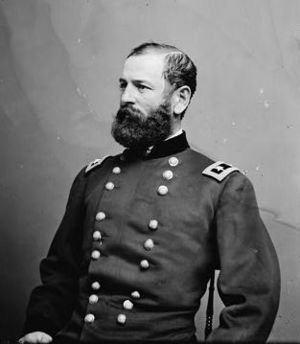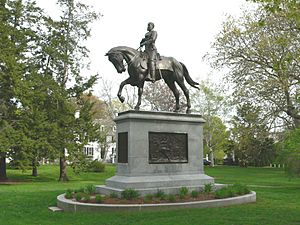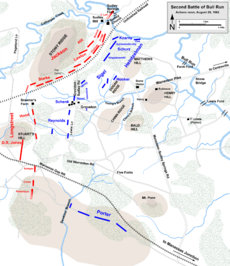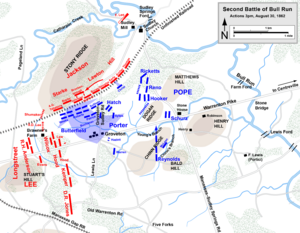Fitz John Porter facts for kids
Quick facts for kids
Fitz John Porter
|
|
|---|---|

Porter Between 1860 and 1870
|
|
| Born | August 31, 1822 Portsmouth, New Hampshire |
| Died | May 21, 1901 (aged 78) Morristown, New Jersey |
| Buried | |
| Allegiance | United States of America Union |
| Service/ |
United States Army Union Army |
| Years of service | 1845–1863; 1886 |
| Rank | |
| Commands held | V Corps, Army of the Potomac |
| Battles/wars | Mexican–American War |
| Other work | Public works commissioner, police commissioner, and fire commissioner (NYC) |
| Signature | |
Fitz John Porter (born August 31, 1822 – died May 21, 1901) was an officer in the United States Army and a general for the Union during the American Civil War. He is best known for his actions at the Second Battle of Bull Run and the military trial, called a court-martial, that followed.
Even though Porter fought well in the early battles of the Civil War, his military career was greatly affected by this controversial trial. After the war, he spent nearly 25 years trying to clear his name. Eventually, he was officially restored to the army's records.
Contents
Early Life and Education
Fitz John Porter was born on August 31, 1822, in Portsmouth, New Hampshire. His family was well-known for serving in the American navy. His cousins included famous naval figures like David Dixon Porter and David Farragut.
Porter had a challenging childhood because his father was often ill. He decided to pursue a career in the army. He attended Phillips Exeter Academy and then the United States Military Academy (West Point), graduating in 1845. He was ranked eighth in his class of 41 cadets. After graduation, he became a second lieutenant in the 4th U.S. Artillery.
Military Career Before the Civil War
Porter was promoted to first lieutenant in 1847. He served in the Mexican–American War, where he showed great bravery. He was recognized for his actions at the Battle of Molino del Rey and the Battle of Chapultepec, where he was wounded. For his courage, he received special temporary promotions, called "brevet" promotions, to captain and then major.
After the war with Mexico, Porter returned to West Point. He taught cavalry and artillery from 1849 to 1853. He also worked as an assistant to the academy's leader until 1855. Later, he was stationed at Fort Leavenworth, Kansas. In 1857 and 1858, Porter served under future Confederate General Albert Sidney Johnston during an expedition to Utah. After this, he helped inspect and improve the defenses of Charleston Harbor. In late 1860, he helped move military personnel out of Texas after the state left the Union.
American Civil War Service
When the Civil War began, Porter became a chief of staff for the Department of Pennsylvania. Soon after, he was promoted to colonel in May 1861. Some people, like General John A. Logan, later accused Porter of helping a Confederate force escape. This escape supposedly helped the Confederates win the First Battle of Bull Run.
In August, Porter was promoted to brigadier general. This promotion was made effective earlier, so he could lead a division in the Army of the Potomac. This army was newly formed under Major General George B. McClellan. Porter quickly became a trusted friend and advisor to McClellan. However, his close connection to McClellan, who would later become controversial, would cause problems for Porter's own military career.
Porter led his division at the start of the Peninsula Campaign. He saw action during the Siege of Yorktown. General McClellan then created two temporary army groups, and Porter was given command of the V Corps. During the Seven Days Battles, especially at the Battle of Gaines' Mill, Porter showed great skill in defending positions. He also played a key role in the Battle of Malvern Hill.
Unexpected Balloon Ride
Porter had an unusual experience during the war when he decided to observe enemy lines from a hot air balloon. He went up without the expert who usually handled the balloon, Professor Thaddeus S. C. Lowe. With only one rope holding it, the balloon broke free! General Porter found himself floating west, right over enemy territory. He was in danger of being captured or even killed.
Luckily, the wind changed, and Porter was able to adjust the gas in the balloon. This allowed him to return safely to the Union lines. Even though it was an embarrassing accident, General Porter successfully observed the enemy's defenses. He recorded what he saw, even though the balloon program was stopped a year later. For his good performance, he was promoted to major general on July 4, 1862.
Second Battle of Bull Run
Porter's V Corps was sent to help Major General John Pope during the Northern Virginia Campaign. Porter openly disagreed with this assignment and criticized Pope. During the Second Battle of Bull Run on August 29, 1862, Porter was ordered to attack the side and rear of Confederate General Thomas J. "Stonewall" Jackson's forces.
Porter's troops had stopped at Dawkin's Branch, where they met Confederate cavalry. On August 29, Pope sent a message telling Porter to attack the Confederate right side. Pope thought this was Jackson's position. However, Porter also had orders to stay in contact with a nearby division. These orders were confusing and hard to follow. Pope did not know that a large Confederate force under Major General James Longstreet had arrived. If Porter had attacked as ordered, his troops would have run right into Longstreet's much larger army. Porter chose not to attack because he knew Longstreet was directly in front of him.
On August 30, Pope again ordered the attack. Porter reluctantly obeyed. As the V Corps turned to attack Jackson's right, they exposed their own side to Longstreet's waiting men. About 30,000 Confederates attacked Porter's roughly 5,000 soldiers. They pushed through Porter's lines and into the rest of Pope's army. This was exactly what Porter had feared would happen if he followed the orders. Pope was furious about the defeat. He accused Porter of not following orders and removed him from command on September 5.
Porter was soon given back command of his corps by McClellan. He led them through the Maryland Campaign, where they were held in reserve during the Battle of Antietam. Porter reportedly told McClellan, "Remember, General, I command the last reserve of the last Army of the Republic." McClellan seemed to take this advice and did not send his reserves into the battle. Many believe the battle might have been won if he had used his forces more aggressively.
Military Trial and Aftermath
On November 25, 1862, Porter was arrested and faced a military trial, known as a court-martial, for his actions at Second Bull Run. By this time, President Abraham Lincoln had removed McClellan from command, so McClellan could not protect Porter. Porter's close ties to McClellan and his open criticism of Pope were major reasons for his conviction. On January 10, 1863, Porter was found guilty of not obeying orders and misbehavior. He was officially removed from the Army on January 21, 1863.
A Confederate officer, Edward Porter Alexander, later wrote that Confederates who knew Porter respected him greatly. They saw his dismissal as a big benefit of their victory.
Later Life and Clearing His Name
After the Civil War ended, Porter was offered a command in the Egyptian Army, but he said no. He spent most of the rest of his life fighting against what he felt was an unfair military trial.
In 1878, a special group led by General John Schofield looked into Porter's case again. They found that Porter's decision not to attack Longstreet likely saved Pope's army from an even worse defeat. Eight years later, President Grover Cleveland officially reduced Porter's punishment. A special law passed by the U.S. Congress restored Porter's rank as an infantry colonel in the U.S. Army. This was backdated to May 14, 1861, but he did not receive any back pay. Two days later, on August 7, 1886, Porter felt his name was cleared and chose to retire from the Army.
Porter also worked in other fields, including mining, construction, and business. He was appointed as the Commissioner of Public Works, Police Commissioner, and Fire Commissioner for New York City.
On December 27, 1894, Porter and 18 others started a military society called the Military and Naval Order of the United States, which later became the Military Order of Foreign Wars. Porter's name was first on the list of founders, and he received the first award given by the Order.
Fitz John Porter died in Morristown, New Jersey. He is buried in Green-Wood Cemetery in Brooklyn, New York.
Legacy

- In 1862, a military camp called Camp Fitz-John Porter was set up in Monroe County, NY. It was a place where soldiers gathered before going to war.
- In 1904, a statue of Porter was put up in Haven Park in Portsmouth, New Hampshire. It was designed by artist James E. Kelly.
- A ship was named in his honor, the In World War II, the United States liberty ship SS FitzJohn Porter was named in his honor..
- Porterstown Road, in a town of the same name, runs through the area where his forces were positioned during the Battle of Sharpsburg.
- His home in Portsmouth is listed on the National Register of Historic Places, which recognizes important historical places.
See also
 In Spanish: Fitz John Porter para niños
In Spanish: Fitz John Porter para niños
- List of American Civil War generals (Union)
- List of people pardoned or granted clemency by the president of the United States




